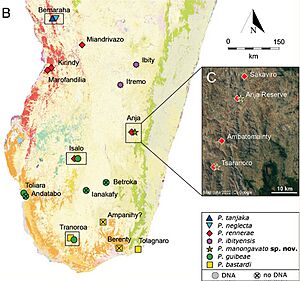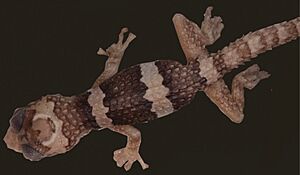Mocquard's Madagascar ground gecko facts for kids
Quick facts for kids Mocquard's Madagascar ground gecko |
|
|---|---|
 |
|
| Wild adult at Berenty Reserve | |
| Conservation status | |
| Scientific classification | |
| Genus: |
Paroedura
|
| Species: |
bastardi
|
 |
|
| Range of the species within the Paroedura bastardi clade, with P. bastardi indicated by the yellow squares | |
| Synonyms | |
|
|
The Mocquard's Madagascar ground gecko (Paroedura bastardi) is a type of lizard from the gecko family. This medium-sized reptile grows to about 7 cm (2.8 in) long, not counting its tail. It lives only in southeastern Madagascar, where it can be found on the ground or climbing trees.
For a long time, scientists thought this gecko lived all over western and southern Madagascar. But new studies using its body shape and DNA showed that it was actually many different, very similar species. These are called a "species complex." Now, we know that the "true" P. bastardi lives only in the far southeast of Madagascar.
Contents
About the Mocquard's Madagascar Ground Gecko
How the Gecko Got Its Name
The Mocquard's Madagascar ground gecko was first described in 1900. A scientist named François Mocquard gave it the scientific name Phyllodactylus bastardi. The second part of its name, bastardi, honors a French scientist named Eugène Joseph Bastard.
Later, in 1974, many geckos from Madagascar that were in the Phyllodactylus group were moved to a new group called Paroedura. This included the Mocquard's Madagascar ground gecko, which then became Paroedura bastardi.
Understanding the Gecko Family Tree
Scientists use special tests, like looking at DNA, to understand how different animals are related. These tests showed that what was thought to be one species, P. bastardi, was actually a group of very similar but separate species. These are called "cryptic species" because they look so much alike.
For example, the Ibity ground gecko was once thought to be a type of Mocquard's gecko. But in 2008, it was recognized as its own separate species. Other hidden species have also been found and given their own names, like Paroedura guibeae, Paroedura rennerae, and Paroedura manongavato.
Scientists often use a diagram called a cladogram to show how species are related. Here is how P. bastardi fits in with its closest relatives:
|
|||||||||||||||||||||||||||||||||||||||||||
Where the Gecko Lives and Its Home
Older information often says that the Mocquard's Madagascar ground gecko lives across western and southern Madagascar. It was thought to live in dry forests, shrubland, and rocky areas, from 40 m (130 ft) to 800 m (2,600 ft) high.
However, this wide range was for the whole group of similar species. Now we know that the "true" Paroedura bastardi lives only in the very southeastern part of Madagascar. Other similar geckos, like P. rennerae and P. guibeae, live in other parts of the island. Sometimes, different types of these geckos can even be found living in the same area, like P. bastardi and P. guibeae in a place called Tranoroa.
What the Gecko Looks Like
The Mocquard's Madagascar ground gecko is a medium-sized gecko. Its body, from its snout to where its tail begins, is about 7.1–7.3 cm (2.8–2.9 in) long. Its head is shaped like a triangle and is wider than its neck. The opening for its ear is a thin, vertical slit.
Like its close relatives, this gecko has large, bumpy scales on its back. These scales are arranged in rows. Its tail has spiny bumps, which are more organized on young geckos. Its legs are strong, and its toe pads have special ridges called lamellae. These help the gecko grip surfaces and are wider than the rest of its toes.
The gecko's body is a brown color with gray spots and three lighter bands across its back. These bands are brightest on young geckos, where they might be white with dark edges. On adult geckos, the bands are not as clear. Young geckos also have a special "butterfly or bat-shaped" pattern on their heads, which fades as they get older. Their toes do not have bands.
Gecko Behavior and Life Cycle
This gecko mostly lives on the ground but can also climb. You might see it on the ground or on tree trunks. When handled, these geckos and their relatives are known to bite quickly. This is likely a way for them to protect themselves.
The Mocquard's Madagascar ground gecko lays eggs. The female gecko buries her eggs in the ground. Even though this species can live in the same area as Paroedura guibeae, they do not breed with each other.
Conservation Status
In 2011, the IUCN listed this species as "Least Concern." This meant they thought it was widespread and not likely to be in danger. However, this was before scientists realized that what they thought was one species was actually many different ones. Now, the "true" Paroedura bastardi's home is known to be much smaller.
Madagascar has lost a lot of its forests since the 1950s due to deforestation and slash-and-burn farming. This habitat loss threatens some related gecko species. It's not yet confirmed if the Mocquard's Madagascar ground gecko is also being affected. These geckos are sometimes collected for the wildlife trade, but how much this affects them is not fully known.
Gallery






